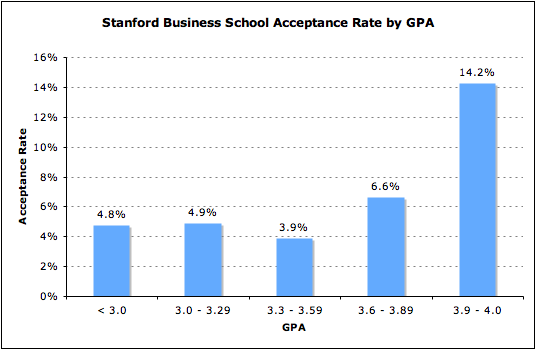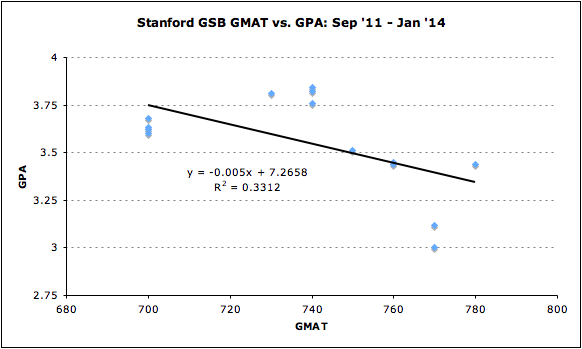Many applicants may wonder if their undergraduate major impacts their chance of getting into business school. Admissions data suggests that your college major can significantly impact your probability of getting into business school. The general trend seems to be that majors that are more dominated by women have a higher acceptance rate while industries that dominated by men had lower acceptance rates. This could be because my data does not have gender as a variable, so I could not account for it. Many people believe that women’s acceptance rate is higher than it is for men with similar credentials, but I have not found any data that proves it. Another explanation is that the female dominated majors are generally underrepresented in business school application pools, so when schools aim to diversify the class, the acceptance rates are higher for those majors. Continue reading
Category Archives: Stanford
MBA Waitlist Acceptance Rate Analysis (with Class of 2019 data)
 One of the most frustrating parts of the MBA application process is waiting to hear back from the schools. First, applicants have to wait to hear if you will be interviewed. Next, an applicant must wait to hear if they have been admitted. Some unlucky souls will have to wait a third time on the waitlist, sometimes for up to 8 months if they are a round 1 applicant. I created this updated MBA waitlist acceptance rate analysis to provide some transparency to those who are on the waitlist. Continue reading
One of the most frustrating parts of the MBA application process is waiting to hear back from the schools. First, applicants have to wait to hear if you will be interviewed. Next, an applicant must wait to hear if they have been admitted. Some unlucky souls will have to wait a third time on the waitlist, sometimes for up to 8 months if they are a round 1 applicant. I created this updated MBA waitlist acceptance rate analysis to provide some transparency to those who are on the waitlist. Continue reading
MBA Interview Probability for top schools by GMAT and GPA
With round 2 application deadlines rapidly approaching, many applicants may wonder what their chance of getting an MBA interview with their favorite schools is. I analyzed the MBA interview probability for the top 25 schools over the past 5 years by GMAT and GPA. Unsurprisingly, for most schools the MBA interview chance increased for high GMAT and high GPA candidates. Continue reading
Military MBA Acceptance Rate Analysis
 Transitioning from the military to MBA is a fairly popular path to follow. A little over 4% of MBA applications come from military veterans. When looking at the data comparing military applicants to traditional MBA applicants, a few trends become clear:
Transitioning from the military to MBA is a fairly popular path to follow. A little over 4% of MBA applications come from military veterans. When looking at the data comparing military applicants to traditional MBA applicants, a few trends become clear:
- Military / Veteran applicants tend to be a year or two older.
- Scores for military applicants are a little lower on average, about 15 points on the GMAT and about .15 for GPA
- Military applicants on average have another year or two of work experience
- Military MBA acceptance rate is about 50% higher than the acceptance rate for traditional applicants
- Some schools have a very large advantage for military applicants while others have little to no advantage
Best Schools for Young MBA Applicants
Deciding when to start applying to business school can be a challenge. Salary increases dramatically after an MBA, but schools tend to prefer applicants with more work experience. I looked at the top 25 US MBA programs’ admission data to find the best schools for young MBA applicants in terms of chance of being admitted. I analyzed the MBA acceptance rate by age to see which schools had the smallest disadvantage for younger applicants relative to traditionally aged MBA applicants. Continue reading
Updated MBA Acceptance Rate by Round
The third round of MBA applications is notorious for having a lower acceptance rate. With the third round application deadlines approaching quickly for most business schools, you may be wondering if the stereotype about the third round is fact or fiction. I updated my analysis of MBA acceptance rate by round with the last 2 years of data and I expanded it to include Olin, Georgetown, USC, Arizona State and Vanderbilt.
This analysis was done using self-reported data from GMAT Club. Data from the class of 2014 through the class of 2018 was used because otherwise there would not be enough data for round 3 and 4 to accurately capture the acceptance rate. Continue reading
MBA Round 3 Application Deadline
It is mid March and the application season for the class of 2019 is winding down. If you plan to apply for this year, you should check the MBA Round 3 Application Deadline for the school of your dreams because it is fast approaching or already past. Also, check out the MBA acceptance rate for round 3 at the schools you are considering. Continue reading
McKinsey Emerging Scholars
For all of you soon to be MBA Students interested in consulting, McKinsey has a great opportunity for you. Apply for the McKinsey Emerging Scholars program by May 19th 2016. If you are selected to be a scholar, then you will receive a monetary award, mentorship from McKinsey consultants and an invitation to a celebratory event. Continue reading
Optimal MBA Application Number
Many business school applicants wonder how many MBA applications they should submit? In this article, I will discuss the optimal MBA application number based on real data. Deciding on your MBA application number is challenging because the more schools you apply to, the less time you have to spend on each application. On the other hand, you don’t want to put all of your eggs into one or two baskets. The data suggests that the ideal number of MBA applications is 5 to 7. For more information, check out this article on how to build your portfolio of MBA applications co-authored by Lawrence Linker and I. Continue reading
Strategies on Building Your MBA Application Portfolio
As Founder and Application Coordinator for MBA Link, one of the first things I’m often consulted on is how many schools an applicant should apply to and which ones. This is an extremely important step to get right in the application process, because there is almost no other decision you will make along the way that has a greater influence on how likely it is you will end up getting into a school with which you will be happy. Continue reading
Low GPA MBA Acceptance Rate Analysis
Many applicants worry about applying to business school if they have a low GPA. I analyzed the low GPA MBA acceptance rate at the top 25 schools to see what are the realistic chances for applicants with a GPA below 3.0. In my data sample from GMAT Club, less than 3% of applicants had a low GPA, which I defined as below 3.0. Individual schools did not have enough data for me to analyze in depth, so I grouped schools into clusters for analysis. I was surprised to see that low GPA MBA acceptance rate is a lot higher than I expected. Continue reading
MBA Interview Acceptance Rate by GMAT and GPA
The interview is a crucial component of the MBA admission process. All top full-time MBA programs interview applicants before admitting them. Generally the MBA admissions committee is looking for two things during the interview, that you fit the culture of the school and that you have the emotional intelligence to succeed at business school. I have already looked at MBA Interview acceptance rate by itself. However, I always wondered when applying to business school if all applicants are considered equal after they have been invited to interview or does the rest of the application, like the GMAT and GPA, still matter. It turns out that it matters at some schools and not at others. Continue reading
Stanford MBA Acceptance Rate Analysis
When I first built the Stanford MBA acceptance rate model, it showed that GPA had little to no impact on acceptance rate. I have reevaluated the data and now I believe that GPA does matter when applying to Stanford. Although GPA has an impact on acceptance, GMAT is still more important for Stanford MBA admissions. Continue reading
MBA Acceptance Rate by Concentration
With the current semester just about over, next years application essay questions will be posted in the coming weeks for many schools. Round one applicants should start figuring out their story and crafting their essays. The most important essay for most schools is the question: Why get an MBA and why is [insert school name here] the right choice for you? In order to answer this question you need to have a plan for how an MBA is going to help you achieve your goals. The vast majority of MBA students are looking to switch careers. Why else pay $120,000 in tuition and give up two years of salary? If you wanted to stay in the same industry, you would probably just go for a promotion or switch companies. Continue reading
MBA Waitlist Acceptance Rate Rank
A more up-to-date analysis of MBA waitlist acceptance rate has been completed which include admissions data for the class of 2019.
At this point in the year many applicants have been placed on the waitlist for the school of their dreams. It is a frustrating experience that I personally have experienced. This articles shows the MBA waitlist acceptance rates for the top US MBA programs. The data for this analysis comes from GMATClub. These acceptance rates are meant to give a rough idea of the waitlist acceptance rate and should be taken with a grain of salt. The sample sizes vary by school; Olin, Emory and Stanford have the lowest sample sizes.
MBA Waitlist Acceptance Rate by School Rank
| US News Rank | School | Waitlist Acceptance Rate |
|---|---|---|
| 1 | Stanford | 9% |
| 2 | Harvard | 2% |
| 3 | Wharton | 6% |
| 4 | Booth | 15% |
| 5 | Sloan | 8% |
| 6 | Kellogg | 6% |
| 7 | Haas | 4% |
| 8 | Columbia | 6% |
| 9 | Tuck | 10% |
| 10 | Darden | 16% |
| 11 | NYU | 3% |
| 11 | Ross | 11% |
| 13 | Duke | 4% |
| 13 | Yale | 3% |
| 15 | Anderson | 18% |
| 16 | Cornell | 11% |
| 17 | McCombs | 8% |
| 18 | Kenan-Flagler | 46% |
| 19 | Olin | 30% |
| 20 | Tepper | 13% |
| 21 | Emory | 4% |
MBA waitlist acceptance rates ranges widely from 46% to 2% depending on the school. It tends to vary quite a bit from year to year, so these acceptance rates should only be used as a guide. For example Dartmouth’s average waitlist acceptance rate is 10%, however for the class of 2016 it was only 2%. The top ten schools on average have a slightly lower waitlist acceptance rate coming in at 8% while the next ten schools average a noticeably higher acceptance rate of 14%.
MBA Waitlist Acceptance Rate Rank
| Acceptance Rank | School | Waitlist Acceptance Rate |
|---|---|---|
| 1 | Kenan-Flagler | 46% |
| 2 | Olin | 30% |
| 3 | Anderson | 18% |
| 4 | Darden | 16% |
| 5 | Booth | 15% |
| 6 | Tepper | 13% |
| 7 | Ross | 11% |
| 8 | Cornell | 11% |
| 9 | Tuck | 10% |
| 10 | Stanford | 9% |
| 11 | Sloan | 8% |
| 12 | McCombs | 8% |
| 13 | Kellogg | 6% |
| 14 | Wharton | 6% |
| 15 | Columbia | 6% |
| 16 | Emory | 4% |
| 17 | Duke | 4% |
| 18 | Haas | 4% |
| 19 | Yale | 3% |
| 20 | NYU | 3% |
| 21 | Harvard | 2% |
The schools with the highest MBA waitlist acceptance rates are Kenan-Flagler, Olin, and Anderson. At the other end are Harvard, NYU and Yale with the lowest waitlist acceptance rates. Although NYU has the highest interview acceptance rate, it rarely accepts anyone off the waitlist.
MBA Acceptance Rate by Application Round
Some business schools have roughly the same acceptance rate during all rounds while others see a significant drop off in later rounds. With applications for round 3 due in the next month or two, this analysis may help you decide which schools to focus on and which to avoid. Here is a list of the top 20 schools’ MBA acceptance rates by application round. The data for this analysis came from GMAT Club, which may be a biased sample. People on GMAT Club tend to have higher GMAT scores than the general applicant pool, so the acceptance rate can be significantly higher for some schools. The acceptance rates are meant to give you an idea of the relationship between rounds, not the absolute acceptance rate. These numbers are raw and not adjusted for other variables such as GMAT and GPA.
MBA Acceptance Rate by Round
The first table is MBA acceptance rates by round ordered by school ranking. The acceptance rates that have a star next to them means that the sample size is very small and might not be very accurate.
| US News Rank | School | Round 1 | Round 2 | Round 3 | Round 4 |
|---|---|---|---|---|---|
| 1 | Stanford | 8% | 5% | 2% | - |
| 1 | Wharton | 19% | 16% | 0%* | - |
| 1 | Harvard | 12% | 6% | 4% | - |
| 4 | Booth | 29% | 25% | 15% | - |
| 5 | MIT | 16% | 11% | - | - |
| 6 | Kellogg | 26% | 23% | 20%* | - |
| 7 | Haas | 17% | 17% | 6% | |
| 8 | Columbia | 23% | 20% | - | - |
| 9 | Tuck | 28% | 29% | 22% | 9% |
| 10 | NYU | 29% | 27% | 21% | |
| 11 | Ross | 41% | 42% | 38%* | - |
| 11 | Darden | 32% | 33% | 16% | - |
| 13 | Yale | 24% | 27% | 9% | - |
| 14 | Duke | 31% | 33% | 21% | - |
| 15 | McCombs | 38% | 36% | 28% | - |
| 16 | Anderson | 26% | 34% | 9% | - |
| 17 | Johnson | 39% | 36% | 37% | - |
| 18 | Tepper | 24% | 38% | 43% | - |
| 19 | Kenan-Flagler | 36% | 40% | 60% | - |
| 20 | Emory | 26% | 40% | 37% | - |
Schools with Significantly Lower Round 3 Acceptance Rate
Many of the top 20 MBA programs have significantly lower acceptance rates in round 3 to the point where it is better to wait until next year to apply. Harvard, Stanford and Wharton, the number one ranked schools, have a large decrease in acceptance rate for round 3. Only 2% to 3% of applications for these schools are in round 3 because everyone knows that acceptance rates are so low. Haas, Yale, Duke, UVA and UCLA also see a significant drops in round 3 admissions compared to earlier rounds. Dartmouth has a respectable round 3 acceptance rate of 22%, but a very low 9% chance of admission for round 4.
Schools with Similar or Higher Round 3 Acceptance Rate
While many schools have a lower acceptance rate for round 3, there are several schools that don’t have a drop off in response. Ross, Cornell, and Emory all have similar admission odds for the third round, while Tepper and UNC actually have a higher acceptance rate for round 3.
Round 3 MBA Acceptance Rate Ranking
This is the the same table as the first one but ranked by round 3 acceptance rate from highest to lowest. Some schools have a round 4 that I did not include, because the sample size was too small. I combined round 4 applications with round 3 except for Tuck because Dartmouth actually had a large number of round 4 applicants.
| Round 3 Rank | School | Round 1 | Round 2 | Round 3 | Round 4 |
|---|---|---|---|---|---|
| 1 | Kenan-Flagler | 36% | 40% | 60% | - |
| 2 | Tepper | 24% | 38% | 43% | - |
| 3 | Ross | 41% | 42% | 38%* | - |
| 4 | Johnson | 39% | 36% | 37% | - |
| 4 | Emory | 26% | 40% | 37% | - |
| 6 | McCombs | 38% | 36% | 28% | - |
| 7 | Tuck | 28% | 29% | 22% | 9% |
| 8 | NYU | 29% | 27% | 21% | |
| 8 | Duke | 31% | 33% | 21% | - |
| 10 | Kellogg | 26% | 23% | 20%* | - |
| 11 | Darden | 32% | 33% | 16% | - |
| 12 | Booth | 29% | 25% | 15% | - |
| 13 | Yale | 24% | 27% | 9% | - |
| 13 | Anderson | 26% | 34% | 9% | - |
| 15 | Haas | 17% | 17% | 6% | |
| 16 | Harvard | 12% | 6% | 4% | - |
| 17 | Stanford | 8% | 5% | 2% | - |
| 18 | Wharton | 19% | 16% | 0%* | - |
| 19 | MIT | 16% | 11% | - | - |
| 19 | Columbia | 23% | 20% | - | - |
The most surprising number is UNC Kenan-Flagler’s round 3 acceptance rate of 60%, which is significantly higher than that of round 1 and 2. I looked at the GMAT and GPA for each round to see if they would explain the high admissions in round 3, however they were both slightly lower than other rounds. I can’t explain why UNC round 3 acceptance rate is so high, but it is a great school to apply to in the third round.
By request, below is the GMAT, GPA and age for Harvard and Booth by round. Round 3 data does not have a ton of data, so take this with a grain of salt.
| School | Variable | R1 | R2 | R3 |
|---|---|---|---|---|
| Booth | GMAT | 735 | 739 | 728 |
| Booth | GPA | 3.61 | 3.62 | 3.58 |
| Booth | Age | 27 | 28 | 29 |
| Harvard | GMAT | 735 | 728 | 720 |
| Harvard | GPA | 3.61 | 3.57 | 3.54 |
| Harvard | Age | 27 | 27 | 27 |
* Sample size is 30 or fewer applications.
MBA Interview Acceptance Rate Rankings
So you have just been invited to interview at the MBA school of your dreams. Obviously this raises your chance of getting in, but by how much? In general, top ten schools have lower MBA interview acceptance rates while schools ranked 11 to 20 have a higher acceptance rate for applicants who were interviewed.
MBA Interview Acceptance Rate by Rank
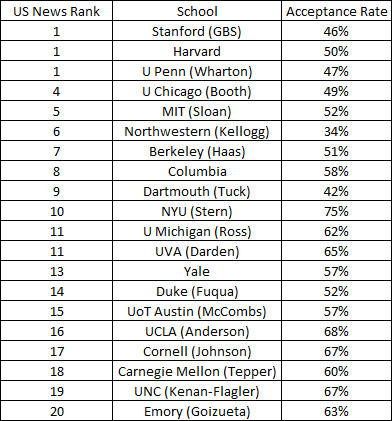
Interview acceptance rate for Stanford, Harvard, Wharton, Booth, MIT, Kellogg, Hass, Columbia, Dartmouth, NYU, Ross, Darden, Yale, Duke, McCombs, Anderson, Cornell, Tepper, Kenan-Flagler, Emory
The acceptance rate ranges from 34% to 75% for schools in the top 20. The average MBA interview acceptance rate for the top 10 is 50% and it is 62% for schools ranked 11 to 20.
MBA Interview Acceptance Rate Rankings from Highest to Lowest
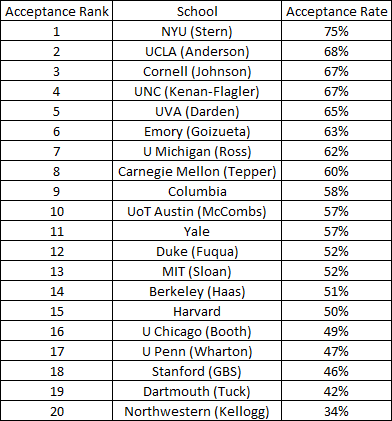 NYU jumps out as the highest acceptance rate by a wide margin. If you have been selected to interview at Stern then you can prepare to open a bottle of champagne because you are probably going to business school. No other school in the top 10 has an interview acceptance rate above 60%.
NYU jumps out as the highest acceptance rate by a wide margin. If you have been selected to interview at Stern then you can prepare to open a bottle of champagne because you are probably going to business school. No other school in the top 10 has an interview acceptance rate above 60%.
On the other end of the spectrum is Kellogg and Tuck with the lowest acceptance rates. These two schools will allow anyone who visits campus to interview, so it is not surprising that they admit significantly fewer applicants who are interviewed. Most of the top 10 schools have an acceptance rate clustered between 46% and 51%.
Duke has the lowest acceptance rate for a school not in the top 10 at 52%. The rest of the schools range from 57% to 68%,
Good luck and don’t forget to prepare for your MBA interviews!
GPA Trivial to Stanford Business School Acceptance Rate
Although the original predictive model I built for Stanford suggested that GPA didn’t matter, I updated the model using different data cleaning techniques and I now believe that GPA is important to Stanford. Although GPA does matter, GMAT is still much more important. The new Stanford MBA Acceptance Rate Analysis can be found here.
Stanford business school has the lowest acceptance rate of 6% out of all MBA programs in the US. I am sure everyone wants to know the secret to increase their Stanford business school acceptance rate. Shockingly Stanford GBS does not care about your GPA. I built a statistical model to predict Stanford business school acceptance rate, and there was no evidence that a high GPA increases your chance of admission at Stanford.
Stanford Business School Acceptance Rate by GMAT
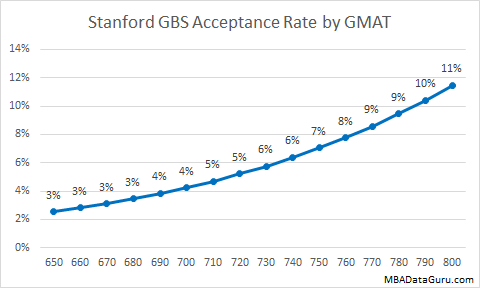 The graph above shows how Stanford business school acceptance rate changes based on GMAT. There is a strong relationship between GMAT and Stanford MBA acceptance rate. Surprisingly, even with an 800 GMAT your chance of admission is still only 11%. Since there are over 7,000 applicants for only 400 spots it is difficult to be accepted.
The graph above shows how Stanford business school acceptance rate changes based on GMAT. There is a strong relationship between GMAT and Stanford MBA acceptance rate. Surprisingly, even with an 800 GMAT your chance of admission is still only 11%. Since there are over 7,000 applicants for only 400 spots it is difficult to be accepted.
Stanford Business School Acceptance Rate by GPA
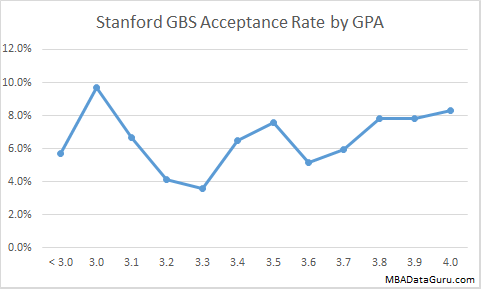 Although GMAT is important to GBS, there is no relationship between GPA and acceptance rate. This is completely the opposite of Harvard where GPA is more important than GMAT. Surprisingly the highest admission rare is for applicants with a 3.0 GPA. Don’t worry too much about the high acceptance rate for low GPAs, there were only 28 applicants with a 3.0, which is not enough of a sample size to be confident. There is however enough data to confirm that there is no strong relationship between GPA and admissions. For those stats nerds out there, the P-value for the GPA variable was 33%, so clearly it had to be eliminated.
Although GMAT is important to GBS, there is no relationship between GPA and acceptance rate. This is completely the opposite of Harvard where GPA is more important than GMAT. Surprisingly the highest admission rare is for applicants with a 3.0 GPA. Don’t worry too much about the high acceptance rate for low GPAs, there were only 28 applicants with a 3.0, which is not enough of a sample size to be confident. There is however enough data to confirm that there is no strong relationship between GPA and admissions. For those stats nerds out there, the P-value for the GPA variable was 33%, so clearly it had to be eliminated.
Stanford Business School Acceptance Rate by Round
 Although GPA doesn’t affect Stanford MBA admission rate, the round you apply in does have a large impact on your chances. The acceptance rate for round one is already below 8% and only drops even lower after that. This is similar to Harvard where application round has a strong impact on acceptance rate. If you are not a perfect candidate with great GMAT and work experience, don’t even bother with round 2 or 3. Might as well wait until next year’s round one unless you enjoy throwing away $250 on your application.
Although GPA doesn’t affect Stanford MBA admission rate, the round you apply in does have a large impact on your chances. The acceptance rate for round one is already below 8% and only drops even lower after that. This is similar to Harvard where application round has a strong impact on acceptance rate. If you are not a perfect candidate with great GMAT and work experience, don’t even bother with round 2 or 3. Might as well wait until next year’s round one unless you enjoy throwing away $250 on your application.
The only other factor that impacts acceptance rate is your pre-MBA industry. Consultants have a 9% acceptance rate compared to other candidates’ 6% chance of admission to GBS. Undergraduate major, years of work experience, and age have no affect on your chances at Stanford business school.
The data used to do this analysis came from GMAT Club website.
Stanford GPA Impact on Acceptance
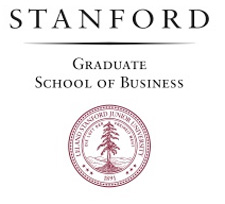
Stanford is the most select MBA program in the country. If you hope to be accepted, then you need to put together a very strong application. It is important to understand how at Stanford GPA will impact your chance of admission before deciding if you want to apply.
Unfortunately, once you finish your undergraduate degree, you GPA is set in stone. At this point the only metric you can improve is your GMAT. However, knowing where you stand with GPA can help you to set your GMAT goal so that you still have a competitive chance of being admitted by Stanford.
Stanford GPA by Acceptance Rate
As you can see, at Stanford GPA has little impact on acceptance rate until it increases over 3.6. Above 3.6, acceptance rate increases by almost 50% compared to below 3.6. Applicants who have a GPA that is higher than 3.9 have a 200% higher chance of being admitted compared to students below 3.6. Although the below 3.0 applicants do not seem to suffer from a lower acceptance rate than applicants with a 3.0 to 3.6, the data for that population is very thin and is likely to have significant error. It is reasonable to assume that it will be difficult to be admitted at Stanford with a GPA below 3.0.
If you are luck enough to be invited by Stanford for an interview. It is important to work hard during interview preparation to maximize your chance of admission. Top MBA programs put a lot of weight on interpersonal skills, so you don’t want to slack off when it comes to the interview.
To create this Stanford GPA analysis, I used data from GMAT Club. The data included applicants for the class of 2014, 2015 and round 1 of 2016.
More recent analysis on the impact of GPA on Stanford admission rate shows that GPA is not an important factor, but GMAT is.
Stanford GMAT vs. GPA: Which is more important?
 Stanford is tied currently tied with Harvard and Wharton as the #1 MBA program in the world. Stanford’s acceptance rate is extremely low, at 6.8%. With such a low acceptance rate, it is important to understand how at Stanford GMAT and GPA affect your chance of admissions. Every school weighs the importance of GMAT and GPA differently. Today I will look at how Stanford compares the two metrics. For this analysis, I only included applicants who were accepted and are on the margin. We don’t learn much by seeing that Stanford accepted a student with a 3.98 GPA and a 790 GMAT, but we do learn a lot by analyzing the profile of applicants who were just barely accepted. Top MBA schools prefer candidates with high GPA and GMAT, but they are often willing to accept an applicant with low GPA if that applicant has a high GMAT. The same is true for applicants with low GMAT and high GPA.
Stanford is tied currently tied with Harvard and Wharton as the #1 MBA program in the world. Stanford’s acceptance rate is extremely low, at 6.8%. With such a low acceptance rate, it is important to understand how at Stanford GMAT and GPA affect your chance of admissions. Every school weighs the importance of GMAT and GPA differently. Today I will look at how Stanford compares the two metrics. For this analysis, I only included applicants who were accepted and are on the margin. We don’t learn much by seeing that Stanford accepted a student with a 3.98 GPA and a 790 GMAT, but we do learn a lot by analyzing the profile of applicants who were just barely accepted. Top MBA schools prefer candidates with high GPA and GMAT, but they are often willing to accept an applicant with low GPA if that applicant has a high GMAT. The same is true for applicants with low GMAT and high GPA.
Stanford GMAT vs. GPA
Unfortunately, Stanford data is a little thin because their acceptance rate is so low, but we get a reasonable idea of the GMAT vs. GPA tradeoff. At Stanford GMAT vs. GPA slope is -.005, which means that 100 GMAT points are roughly worth .5 GPA points. So a 680 GMAT with a 3.87 GPA would be viewed roughly similar to a 780 GMAT with a 3.37 GPA. This slope is less steep than most other schools, which means that, compared to other schools, Stanford prefers high GPA over high GMAT. The only school with a lower slope is Stern, which had a -.0043.
Check out how some of the other schools weigh GMAT vs. GPA:
The data for this post is from GMAT Club. I used the admissions data from the class of 2014, 2015, and R1 admits for 2016.
I have published a more recent Stanford business school acceptance rate analysis which has more accurate findings on GMAT and GPA at GBS.


